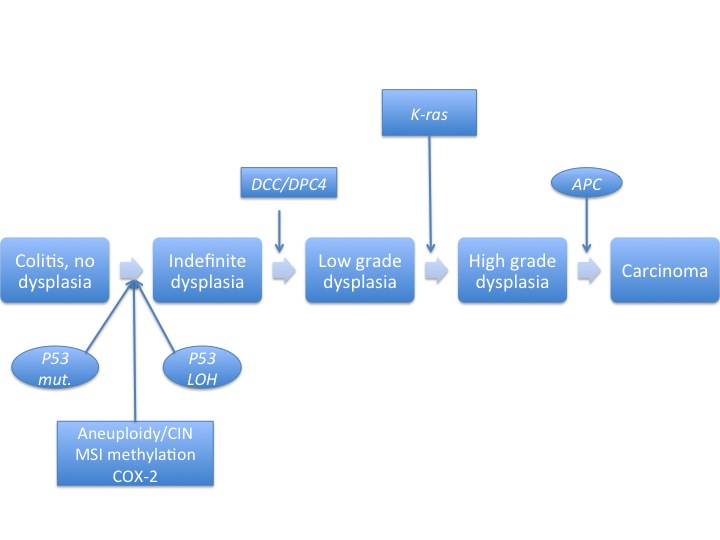Familial adenomatous polyposis natural history, complications and prognosis
|
Familial adenomatous polyposis Microchapters |
|
Differentiating Familial adenomatous polyposis from other Diseases |
|---|
|
Diagnosis |
|
Treatment |
|
Case Studies |
|
Familial adenomatous polyposis natural history, complications and prognosis On the Web |
|
American Roentgen Ray Society Images of Familial adenomatous polyposis natural history, complications and prognosis |
|
FDA on Familial adenomatous polyposis natural history, complications and prognosis |
|
CDC on Familial adenomatous polyposis natural history, complications and prognosis |
|
Familial adenomatous polyposis natural history, complications and prognosis in the news |
|
Blogs on Familial adenomatous polyposis natural history, complications and prognosis |
|
Directions to Hospitals Treating Familial adenomatous polyposis |
Editor-In-Chief: C. Michael Gibson, M.S., M.D. [1] Associate Editor(s)-in-Chief: Sadaf Sharfaei M.D.[2], Mohamad Alkateb, MBBCh [3]
Overview
Familial adenomatous polyposis is a rare disease that usually starts from childhood. Patients with familial adenomatous polyposis develop numerous colon polyps, which may vary from hundreds to thousands, by early twenties. If patients with FAP left untreated, almost all of the colon polyps develop colorectal cancer around 40 years of age. Patients with FAP may have polyps in different organs including the upper gastrointestinal tract. However, the progression of these extra colonic polyps, to malignancy is less than colon polyps. Patients with FAP might develop duodenal and ampullary cancer which are major causes of death following polypectomy. The prognosis of familial adenomatous polyposis is excellent with treatment.
Natural history
Following are a few important facts about the natural history of familial adenomatous polyposis:
- Familial adenomatous polyposis is a rare disease that usually starts during teenage years.[1]
- Patients with FAP usually develop hundreds to thousands colon polyps by the age of early twenties.[2]
- Patients with FAP might be asymptomatic till third decade of their lives or whenever they have malignant transformation to colorectal cancer.
- If left untreated, almost all of the patients with FAP develop colorectal cancer around 40 years of age.
- Patients with FAP might have polyps in different organs including upper gastrointestinal tract. However, their progression to malignancy is less than colon polyps.
Complications
Complications that can develop as a result of familial adenomatous polyposis include:[3][4]
- Colon cancer which has two different pathways according to defect on APC gene:
- 1- Molecular pathogenesis of sporadic colon cancer is as follows:

- 2- Molecular pathogenesis of colitis-associated colon cancer is as follows:

- Duodenal and ampullary cancer:
- They are major causes of death following polypectomy.
- End-viewing and side-viewing duodenoscopy are conducted for surveillance.
Prognosis
- The prognosis of familial adenomatous polyposis is excellent with treatment.
- Without treatment, all patients with familial adenomatous polyposis develop colon cancer at age of 40-50.[2]
References
- ↑ Kennedy, Raelene D.; Potter, D. Dean; Moir, Christopher R.; El-Youssef, Mounif (2014). "The natural history of familial adenomatous polyposis syndrome: A 24year review of a single center experience in screening, diagnosis, and outcomes". Journal of Pediatric Surgery. 49 (1): 82–86. doi:10.1016/j.jpedsurg.2013.09.033. ISSN 0022-3468.
- ↑ 2.0 2.1 Beech D, Pontius A, Muni N, Long WP (2001). "Familial adenomatous polyposis: a case report and review of the literature". J Natl Med Assoc. 93 (6): 208–13. PMC 2594024. PMID 11446392.
- ↑ Iaquinto, Gaetano; Fornasarig, Mara; Quaia, Michele; Giardullo, Nicola; D'Onofrio, Vittorio; Iaquinto, Salvatore; Di Bella, Simone; Cannizzaro, Renato (2008). "Capsule endoscopy is useful and safe for small-bowel surveillance in familial adenomatous polyposis". Gastrointestinal Endoscopy. 67 (1): 61–67. doi:10.1016/j.gie.2007.07.048. ISSN 0016-5107.
- ↑ King, John E.; Dozois, Roger R.; Lindor, Noralane M.; Ahlquist, David A. (2000). "Care of Patients and Their Families With Familial Adenomatous Polyposis". Mayo Clinic Proceedings. 75 (1): 57–67. doi:10.4065/75.1.57. ISSN 0025-6196.
- ↑ 5.0 5.1 Kim, Eun Ran (2014). "Colorectal cancer in inflammatory bowel disease: The risk, pathogenesis, prevention and diagnosis". World Journal of Gastroenterology. 20 (29): 9872. doi:10.3748/wjg.v20.i29.9872. ISSN 1007-9327.